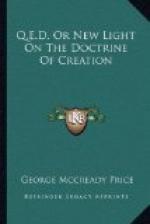The first important step toward the refutation of this old pagan doctrine of spontaneous generation was made by the Italian, Redi, in 1668. He noticed that flies are always present around decomposing meat before the appearance of maggots, and he devised an experiment to keep the flies away from actual contact with the meat. The meat putrified as usual, but did not breed maggots; while the same kind of meat exposed in open jars swarmed with them. He next placed some meat in a jar with some wire gauze over the top. The flies were attracted by the smell of the meat as usual, but could not reach the meat. Instead they laid their eggs upon the gauze, where they hatched in due time, while no maggots were generated in the meat. Thus from this time onward it became gradually understood that, at least in the case of all the larger and higher forms of life, Harvey’s dictum, as announced some years previously, was true, and that life comes only from life.
But the invention of the microscope opened the way for a renewal of the controversy regarding the origin of life. Bacteria were discovered in 1683; and it was soon observed that no precautions with screens or other stoppers could prevent bacteria and other low organisms from breeding in myriads in every kind of organic matter. Here apparently was an entirely new foundation for the doctrine of spontaneous generation. It was freely admitted that all the higher forms of life arise only by process of natural generation from others of their own kind; but did not these microscopic organisms prove that there was “a perpetual abiogenetic fount by which the first steps in the evolution of living organisms continued to arise, under suitable conditions, from inorganic matter"?[9]
[Footnote 9: Encyclopaedia Britannica, Vol. I, p. 64.]
The famous “barnacle-geese” ought not to be omitted from any sketch of the vicissitudes of this doctrine of Biogenesis. An elaborate illustrated account covering their alleged natural history was printed in one of the early volumes of the Royal Society of London. Buds of a particular tree growing near the sea were described as producing barnacles, and these falling into the water were alleged to be transmuted into geese. Nor should we omit mention of Huxley’s Bathybius Haeckelii, a slimy substance supposed to exist in great masses in the depths of the ocean and to consist of undifferentiated protoplasm, the exhaustless fountain from which all other forms of life had been derived. Not long after Huxley had given it a formal scientific name in 1868, it was discovered to be merely a precipitate of gypsum thrown down from sea water by alcohol, and thus a product of clumsy manipulation in the laboratory, instead of a natural product of the deep sea. The disappointment of those opposing biogenesis was severe; but the lesson is still of value to the world to-day.




